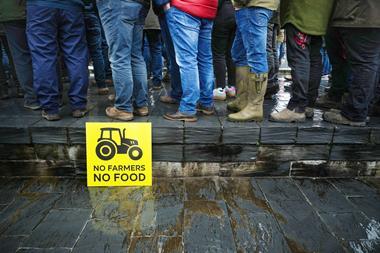DTZ’s unorthodox evaluation could impact on the whole sector. Liz Hamson reports
Robust” and “unconventional” were just two of the words used to describe the valuation of Safeway’s property portfolio carried out by surveyors DTZ last November.
Calculated on the basis of trading performance rather than the value of the underlying asset - the bricks and mortar - the £4.5bn price tag put on just 201 of the chain’s 479 stores was almost £2bn higher than their net book value of £2.56bn.
It flushed out some pretty hefty prospective bids when Safeway cannily released details of the valuation just as it hoisted the “for sale” sign. But as bidders await trade and industry secretary Patricia Hewitt’s announcement next month on who can bid, some leading valuation experts suggest the value has since slumped by as much as 25%. If that is the case, they argue, the door is wide open for the return of the “bargain hunter” venture capitalists.
Eyebrows were raised when DTZ chose to adopt the profits model of valuation (see panel right). Based on the trading performances of the chain’s biggest and most valuable stores, it did not strictly follow Red Book valuation guidelines, which suggest that the underlying asset rather than trading performance should be valued. Moreover, breaking back the £4.5bn figure threw up an equivalent rent of £30 to £35 a square foot, some £15 more than existing top rents in the sector. It raised the prospect, warned the experts, that the non-owner occupier landlords of 30% of the UK’s supermarkets would try to achieve similar valuations through uplifts in rents - forcing a revaluation of the whole sector.
One valuation surveyor acting for an interested party observes: “This is the sort of method you’d usually use for hotels but not supermarkets. Not everyone agreed with it but they obviously felt that it reflected the true value of the property.” The disparity between the figures produced by the two valuations is even more pronounced if you take into account actual rather than top rents, points out a surveyor acting for another party: “I doubt that the average rent would exceed £15.”
The counter-argument put by DTZ was that traditional valuation methods undervalued the portfolio because there was a) very little comparable rental evidence available as so few transactions had taken place and b) what there was tended to have come from rent reviews rather than open market deals and so reflected historic rents rather than current market values. DTZ director, financial consulting, Stephen Clarke, elaborates: “It was a trading based valuation similar to the method used on property assets when the property is integral to the business. Most are owner-occupied so there isn’t an investment market as such, but if you start to look at the prices supermarkets have to pay for sites, given the barriers to entry and the planning restrictions, then you realise that the basis of our valuation is consistent.”
The key driver is sales per square foot, he continues, suggesting that rival supermarkets might feel they could generate more sales than Safeway, potentially justifying an even higher valuation.
DTZ has not disclosed the values it arrived at for individual stores, but some valuation experts have queried whether it attributed lower values to stores in towns where there was competition from rival multiples.
“The argument about towns is irrelevant,” is Clarke’s response. “All the supermarkets want to get their hands on the portfolio because of the planning regulations - whether the stores are in Billericay or Birmingham.” He gives equally short shrift to the overall valuation extrapolated from the figures by some industry observers of circa £6bn. “The 2001 properties were the majority of the portfolio,” he says. Questioned on whether the same valuation method applied now would throw up a lower figure, he refuses to say.
However, a source close to Safeway suggests it could. Although Safeway’s sales were slightly up in the year to May, profits had slipped from £355m to £335m - a slide likely to continue in a protracted battle. There is also the question of who will be allowed to bid. The source says: “The current valuation looks as though it has given due to regard to the potential bidders. But if you stripped out a number of bidders, it could have an impact on the valuation - probably downwards.”
The remaining interested parties could adjust their bids downwards, totally changing the battle stakes.
Another problem, he warns, is the number of stores the trade bidders would be required to divest. “Safeway has a responsibility to its shareholders to maximise its value,” he says. “If the Competition Commission says that you cannot use those properties for food, then you are looking at alternative use values. That would give you a different valuation again, which could well be unacceptable to shareholders.
“If you do not let the big three bid, I can see a scenario where Safeway continues as it is.”
It may not be just idle speculation. The Competition Commission is widely expected to give the green light to a bid from Morrisons and there is a chance Asda will be allowed to put its cards on the bidding table by virtue of its last minute proposal to share the spoils with Morrisons. But both Tesco and Sainsbury are expected to be barred from bidding and if retail entrepreneur Philip Green and the venture capitalists decide not to bid, the predicted fray would fail to materialise. Too few bids could lead to a price that was too low for shareholders to accept.
So where does all this leave potential bidders?
The feeling is that if enough trade buyers are allowed to bid, the price could go substantially beyond £3bn. Despite the higher than usual valuation, the Safeway portfolio is one of the best in the sector. As another surveyor acting for an interested party, puts it: “I don’t necessarily agree with the [DTZ] method but my own personal view is that they came to a realistic valuation - certainly if you look at the cost of assembling sites and developing in the current planning climate.”
He continues: “Some of the stores may have been overvalued, but the counter is that Safeway is not seen as a dominant operator that is getting the most out of its portfolio. If you put another fascia, however, there could be a significant increase in revenue. Because they are getting more, the trade buyers will pay more.”
However, if they are not permitted, the door would be wide open to the opportunists. The likes of US venture capitalist Blackstone are under pressure to spend substantial war chests and have made no secret of the fact that they are interested in UK property deals. The Reuben brothers are also in the market. And no one should rule out Green, who is thought to be taking advice from surveyor Dalgleish. Green is thought to view the DTZ figure as fair, although if he did buy it he would be unlikely to continue operating Safeway as a trading concern for long, raising the question of what he would do with the inevitable rump of properties he would be left with after splitting up and selling off the bulk.
Who will emerge as victor is anybody’s guess. What is clear is that there are unlikely to be many other valuations like DTZ’s. Many surveying firms are obliged to comply with Red Book procedures and would have to follow the conventional model of valuation.
However, if the sale price does reflect the DTZ valuation, it could spell trouble for the supermarkets that are owned by landlords such as British Land, which has substantial exposure to the sector. “There’s a danger that landlords will apply higher rents to under-performing stores - so the supermarkets could lose out in the long run,” warns a source.
“If you get to the stage where rent goes beyond 10% of turnover, retailers start getting twitchy. Retailers are paranoid about the lid coming off rents - because of the rating liability. If there was an across the board revaluation of supermarkets, the rating valuation officers would be wetting themselves.”
Reflection of historic rents
Rump of properties
Robust” and “unconventional” were just two of the words used to describe the valuation of Safeway’s property portfolio carried out by surveyors DTZ last November.
Calculated on the basis of trading performance rather than the value of the underlying asset - the bricks and mortar - the £4.5bn price tag put on just 201 of the chain’s 479 stores was almost £2bn higher than their net book value of £2.56bn.
It flushed out some pretty hefty prospective bids when Safeway cannily released details of the valuation just as it hoisted the “for sale” sign. But as bidders await trade and industry secretary Patricia Hewitt’s announcement next month on who can bid, some leading valuation experts suggest the value has since slumped by as much as 25%. If that is the case, they argue, the door is wide open for the return of the “bargain hunter” venture capitalists.
Eyebrows were raised when DTZ chose to adopt the profits model of valuation (see panel right). Based on the trading performances of the chain’s biggest and most valuable stores, it did not strictly follow Red Book valuation guidelines, which suggest that the underlying asset rather than trading performance should be valued. Moreover, breaking back the £4.5bn figure threw up an equivalent rent of £30 to £35 a square foot, some £15 more than existing top rents in the sector. It raised the prospect, warned the experts, that the non-owner occupier landlords of 30% of the UK’s supermarkets would try to achieve similar valuations through uplifts in rents - forcing a revaluation of the whole sector.
One valuation surveyor acting for an interested party observes: “This is the sort of method you’d usually use for hotels but not supermarkets. Not everyone agreed with it but they obviously felt that it reflected the true value of the property.” The disparity between the figures produced by the two valuations is even more pronounced if you take into account actual rather than top rents, points out a surveyor acting for another party: “I doubt that the average rent would exceed £15.”
The counter-argument put by DTZ was that traditional valuation methods undervalued the portfolio because there was a) very little comparable rental evidence available as so few transactions had taken place and b) what there was tended to have come from rent reviews rather than open market deals and so reflected historic rents rather than current market values. DTZ director, financial consulting, Stephen Clarke, elaborates: “It was a trading based valuation similar to the method used on property assets when the property is integral to the business. Most are owner-occupied so there isn’t an investment market as such, but if you start to look at the prices supermarkets have to pay for sites, given the barriers to entry and the planning restrictions, then you realise that the basis of our valuation is consistent.”
The key driver is sales per square foot, he continues, suggesting that rival supermarkets might feel they could generate more sales than Safeway, potentially justifying an even higher valuation.
DTZ has not disclosed the values it arrived at for individual stores, but some valuation experts have queried whether it attributed lower values to stores in towns where there was competition from rival multiples.
“The argument about towns is irrelevant,” is Clarke’s response. “All the supermarkets want to get their hands on the portfolio because of the planning regulations - whether the stores are in Billericay or Birmingham.” He gives equally short shrift to the overall valuation extrapolated from the figures by some industry observers of circa £6bn. “The 2001 properties were the majority of the portfolio,” he says. Questioned on whether the same valuation method applied now would throw up a lower figure, he refuses to say.
However, a source close to Safeway suggests it could. Although Safeway’s sales were slightly up in the year to May, profits had slipped from £355m to £335m - a slide likely to continue in a protracted battle. There is also the question of who will be allowed to bid. The source says: “The current valuation looks as though it has given due to regard to the potential bidders. But if you stripped out a number of bidders, it could have an impact on the valuation - probably downwards.”
The remaining interested parties could adjust their bids downwards, totally changing the battle stakes.
Another problem, he warns, is the number of stores the trade bidders would be required to divest. “Safeway has a responsibility to its shareholders to maximise its value,” he says. “If the Competition Commission says that you cannot use those properties for food, then you are looking at alternative use values. That would give you a different valuation again, which could well be unacceptable to shareholders.
“If you do not let the big three bid, I can see a scenario where Safeway continues as it is.”
It may not be just idle speculation. The Competition Commission is widely expected to give the green light to a bid from Morrisons and there is a chance Asda will be allowed to put its cards on the bidding table by virtue of its last minute proposal to share the spoils with Morrisons. But both Tesco and Sainsbury are expected to be barred from bidding and if retail entrepreneur Philip Green and the venture capitalists decide not to bid, the predicted fray would fail to materialise. Too few bids could lead to a price that was too low for shareholders to accept.
So where does all this leave potential bidders?
The feeling is that if enough trade buyers are allowed to bid, the price could go substantially beyond £3bn. Despite the higher than usual valuation, the Safeway portfolio is one of the best in the sector. As another surveyor acting for an interested party, puts it: “I don’t necessarily agree with the [DTZ] method but my own personal view is that they came to a realistic valuation - certainly if you look at the cost of assembling sites and developing in the current planning climate.”
He continues: “Some of the stores may have been overvalued, but the counter is that Safeway is not seen as a dominant operator that is getting the most out of its portfolio. If you put another fascia, however, there could be a significant increase in revenue. Because they are getting more, the trade buyers will pay more.”
However, if they are not permitted, the door would be wide open to the opportunists. The likes of US venture capitalist Blackstone are under pressure to spend substantial war chests and have made no secret of the fact that they are interested in UK property deals. The Reuben brothers are also in the market. And no one should rule out Green, who is thought to be taking advice from surveyor Dalgleish. Green is thought to view the DTZ figure as fair, although if he did buy it he would be unlikely to continue operating Safeway as a trading concern for long, raising the question of what he would do with the inevitable rump of properties he would be left with after splitting up and selling off the bulk.
Who will emerge as victor is anybody’s guess. What is clear is that there are unlikely to be many other valuations like DTZ’s. Many surveying firms are obliged to comply with Red Book procedures and would have to follow the conventional model of valuation.
However, if the sale price does reflect the DTZ valuation, it could spell trouble for the supermarkets that are owned by landlords such as British Land, which has substantial exposure to the sector. “There’s a danger that landlords will apply higher rents to under-performing stores - so the supermarkets could lose out in the long run,” warns a source.
“If you get to the stage where rent goes beyond 10% of turnover, retailers start getting twitchy. Retailers are paranoid about the lid coming off rents - because of the rating liability. If there was an across the board revaluation of supermarkets, the rating valuation officers would be wetting themselves.”
Reflection of historic rents
Rump of properties



















No comments yet